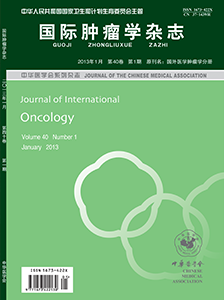The landscape of palliative systemic therapy and overall survival analysis of elderly patients with advanced breast cancer in China National Cancer Center
引用次数: 0
Abstract
Objective To compare the survival data of elderly advanced breast cancer (ABC) patients in China National Cancer Center with USA and summarize the therapeutic characteristics in elderly ABC patients via real world study. Methods We summarized the clinicopathological characteristics, therapeutic regimens and survival outcome of 1 425 females with ABC who were initially hospitalized between January 2003 and December 2013 from Database in China National Cancer Center and compared with 21 185 ABC patients in the Surveillance, Epidemiology, and End Results (SEER) database. Results The median overall survival (OS) of elderly patients was significantly shorter than that of the young group in China National Cancer Center (35.5 months vs. 43.9 months; χ2=8.747, P=0.003), which was similar to the survival feature in SEER database (24.0 months vs. 36.0 months; χ2=540.227, P<0.001). Compared with the young population, significantly more elderly patients suffered from the medical complications of hypertension [30.3% (67/221) vs. 9.5% (114/1 204); χ2=73.073, P<0.001], diabetes [14.5% (32/221) vs. 4.7% (57/1 204); χ2=30.220, P<0.001] and heart disease [6.3% (14/221) vs. 1.7% (20/1 204); χ2=17.638, P<0.001]. In estrogen receptor (ER) and/or progesterone receptor (PR)-positive patients, the percentage of receiving first-line endocrine therapy in elderly patients was significantly larger than that of the young population [26.9% (43/160) vs. 9.5% (80/841); χ2=37.599, P<0.001]. Moreover, in ER and/or PR-positive population, the elderly patients underwent first-line endocrine therapy resulted in better OS than those underwent first-line chemotherapy (49.9 months vs. 32.6 months; χ2=4.774, P=0.029), while no significant difference was observed between these two therapeutic modes in the young population (56.9 months vs. 48.8 months; χ2=1.103, P=0.294). Conclusion The proportion of elderly ABC patients with the medical complication of hypertension, diabetes and heart disease is significantly larger than that of the young population, which may lead to the difference in treatment decision making. In ER and/or PR-positive elderly ABC patients, receiving first-line endocrine therapy may result in better survival than first-line chemotherapy. Key words: Breast neoplasms; Aged; Therapy; Drug therapy中国癌症中心老年晚期乳腺癌患者姑息性全身治疗现状及总生存期分析
目的比较中国国家癌症中心老年晚期乳腺癌(ABC)患者与美国老年晚期乳腺癌患者的生存数据,总结老年晚期乳腺癌患者的治疗特点。方法总结2003年1月至2013年12月中国癌症中心数据库中1 425例首次住院的女性ABC患者的临床病理特征、治疗方案和生存结局,并与SEER数据库中的21 185例ABC患者进行比较。结果中老年患者的中位总生存期(OS)明显短于中青年组(35.5个月vs 43.9个月;χ2=8.747, P=0.003),与SEER数据库中的生存特征相似(24.0个月vs 36.0个月;χ2 = 540.227,P < 0.001)。老年高血压并发症发生率明显高于年轻人群[30.3%(67/221)对9.5% (114/1 204)];χ2 = 73.073,P < 0.001),糖尿病[14.5%(32/221)和4.7% (57/1 204);χ2=30.220, P<0.001]和心脏病[6.3%(14/221)比1.7% (20/1 204);χ2 = 17.638,P < 0.001)。在雌激素受体(ER)和/或孕激素受体(PR)阳性患者中,老年患者接受一线内分泌治疗的比例明显大于年轻人群[26.9%(43/160)比9.5% (80/841);χ2 = 37.599,P < 0.001)。此外,在ER和/或pr阳性人群中,接受一线内分泌治疗的老年患者的OS优于接受一线化疗的患者(49.9个月vs. 32.6个月;χ2=4.774, P=0.029),而两种治疗方式在年轻人群中差异无统计学意义(56.9个月vs 48.8个月;χ2 = 1.103,P = 0.294)。结论老年ABC患者合并高血压、糖尿病、心脏病的比例明显大于年轻人群,这可能导致治疗决策的差异。在ER和/或pr阳性的老年ABC患者中,接受一线内分泌治疗可能比一线化疗有更好的生存率。关键词:乳腺肿瘤;岁的;治疗;药物治疗
本文章由计算机程序翻译,如有差异,请以英文原文为准。
求助全文
约1分钟内获得全文
求助全文

 求助内容:
求助内容: 应助结果提醒方式:
应助结果提醒方式:


